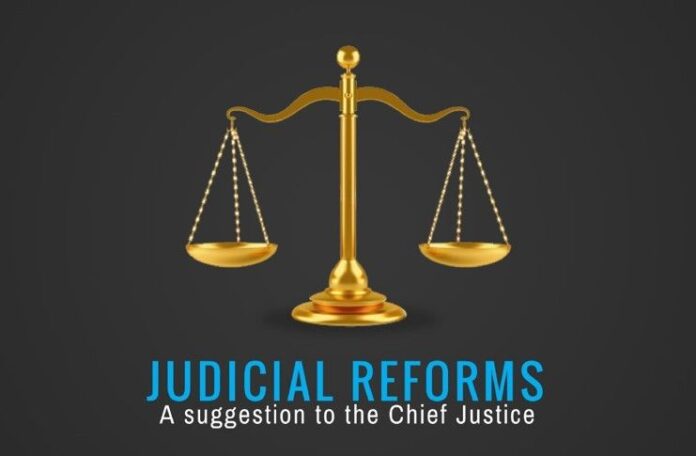
Why are judicial reforms important?
[dropcap color=”#008040″ boxed=”yes” boxed_radius=”8px” class=”” id=””]B[/dropcap]latant cases misuse of power, massive corruption, black money, and criminalisation of politics across India wouldn’t have been possible if the judiciary had delivered timely judgments; it is the non-resolution of cases involving politicians that has enabled those with criminal cases to become law-makers.
There are 1000s of high impact cases like 2G, Vyapam, Vijay Mallya, Lalit Modi, Reddy brothers’ and other mining cases all awaiting justice for long.
The current Tamil Nadu political imbroglio, which would have cost Tamil Nadu 100s of crores of rupees in lost opportunities for the Government and private sectors, wouldn’t have arisen if only the many cases involving Sasikala, had they been resolved in time, either way.
The humongous NPAs of the PSU banks, which have cost the economy dearly, wouldn’t have gone scotfree if the judiciary had resolved cases involving defaulting corporates in reasonable time. There are 1000s of high impact cases like 2G, Vyapam, Vijay Mallya, Lalit Modi, Reddy brothers’ and other mining cases all awaiting justice for long. At least some of the reasons of sickness of MSMEs, which are the main job providers, can be attributed to unresolved payment cases (including cheque bouncing, despite the fast tracking of cheque bouncing cases).
Indian citizens, business & industry are impacted adversely in ever so many ways by the slow justice delivery process. The reasons why people don’t complain is because they feel helpless; they don’t know who can correct it and how.
Overall, the political, social and economic climate will improve manifold if the judiciary becomes more efficient; though it may appear outlandish, it’s fact that our GDP will go up by 1 or 2% if our justice delivery system is speeded up, generating plenty of jobs.
The idea is not to unfairly target the judiciary for the failures of just about everybody, nor to lay all ills at its doorsteps. Sure enough, there are others to blame too, mainly the Governments, but this article just focuses on some reforms the judiciary can initiate. If the CJI of SC brings about significant reforms, he will go down in the history of Indian judicial system as the most transformational leader.
[dropcap color=”#008040″ boxed=”yes” boxed_radius=”8px” class=”” id=””]J[/dropcap]udiciary is one of our least efficient systems. Only those species and systems which encourage cross-breeding will improve and survive. Substantial Judicial Reforms have not happened because the judicial system has always believed in inbreeding.
But if a Rip Wan Winkle lawyer, judge or litigant of 1947 were to wake up and visit a court today, he’ll quite understand most of what’s going on.
If a Rip Wan Winkle doctor, engineer, accountant, industrialist, scientist, or transporter of 1947 were to wake up suddenly from his 7 decades of long sleep and watch professionals engaged in his profession of today, he won’t quite understand what they’re doing; the world has changed so much in these 7 decades. Even if a Rip Wan Winkle were to wake up in his own home today, he will recognise nothing.
But if a Rip Wan Winkle lawyer, judge or litigant of 1947 were to wake up and visit a court today, he’ll quite understand most of what’s going on. Except for the air-conditioners and computers (in some places), nothing much has changed, the same setup of courts, docks, witness boxes, judges, lawyers, clients and arguments… if anything, things have only gotten worse, with more adjournments than hearings and scarce judgments.
Unless judiciary seeks the help of the rest of the society to come up with the kind of automation and efficiency increases they have brought about in other social systems, merely with lawyers searching databases for case laws and secretaries typing judgments using computers, nothing much will change.
[dropcap color=”#008040″ boxed=”yes” boxed_radius=”8px” class=”” id=””]E[/dropcap]very system that has changed has done so due to openness in involving others; judicial system is one of the least open. There are probably only 2 options: either appoint lakhs of new judges and build thousands of courts and clear the backlog, or find a more efficient way. The right choice is obviously the latter.
Most of the hearings and submissions from the parties, in civil as well as criminal cases, can be got in the form of written affidavits, online where possible with Aadhar based (fingerprint and/ or pupil) authentication, with suitable safeguards.
-
Automation strategies should be adopted by the judiciary in a way never thought of before, to make justice affordable, speedy and simpler. e-Courts initiative falls far short of what is possible and desirable, digitising only administrative and documentation aspects.
-
Many core functions of the judicial system can and need to be automated. For example, the average wait time of the parties in courts is very high and average number visits to courts is far too many, most visits ending up in adjournments with scant regard for the loss of time and cost to the parties, as if these don’t matter.
-
Most of the hearings and submissions from the parties, in civil as well as criminal cases, can be got in the form of written affidavits, online where possible with Aadhar based (fingerprint and/ or pupil) authentication, with suitable safeguards. This will save enormous time wasted by the judges, lawyers and parties to cases in courts, and reduce crowds in the courts. The number of visits of the parties to the courts can be minimised. If we do this in just the lower courts where the manpower requirement is highest, we would have solved a very major problem in our judicial system, releasing funds for more critical areas.
-
Judges who hear the cases and deliver the judgments can be different from those writing the judgments (chosen randomly), each specialising in the respective function, which can minimise the chances of corruption. This will also make it necessary for the hearing judges to document the hearings better, as brief for the judge delivering judgment.
These suggestions, only indicative, are too radical to gain acceptance.
Some may argue that such reforms would adversely impact the quality of judgments, as discharge of judicial function can’t be automated. The judgments in the lower courts aren’t great anyway, esp in the context of corruption at lower levels. And I believe, these reforms would only improve the quality of judgments because specialists will handle hearings and judgment writing, reduce delays (for justice delayed is justice denied), and minimise corruption. And the cost of judicial process and backlog will come down due to reduced wastage of time.
Note:
1. The views expressed here are those of the author and do not necessarily represent or reflect the views of PGurus.
- Subramanian Swamy approaches Supreme Court on Govt’s modification of 2G Scam Judgment to avoid auction of Satellite Spectrum - April 23, 2024
- Defence Minister Rajnath Singh visits Siachen. Reviews military preparedness - April 22, 2024
- Amit Shah’s shares in the Stock Market almost doubled in the past five years - April 21, 2024











The whole system needs to be decentralised by having jury trials for all cases at the local level, perhaps using Temple premises to be used as courts and legal experts to administer decisions.
Encouragement to settle disputes by mediation should be encourage in all instances with the use of professional mediators – again the Hindu temples could take part in this process.
Time to bring in Dharmic practices in all areas of govt administration.
Cap time of trial to 1 month for civil and 2 months for criminal cases. Judgements have to be delivered by the end of the terms with no possibility for reserving judgement indefenately/ staying cases.